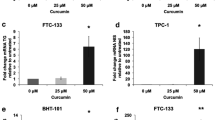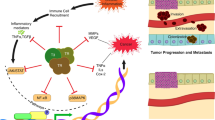Abstract
High iodine intake might be an important factor in the promotion of thyroid cancer and the incidence of thyroid carcinoma has increased obviously these years especially in area of high iodine intake, though the mechanism of which remains unknown. The aim of present study was to gain more insight into the influence of different iodine concentrations on cell behavior, such as proliferation and migration, and to further investigate its molecular mechanism using two well-differentiated thyroid cancer cell lines. Our study evaluated the effect of different iodine concentrations on cell behavior and investigated relevant molecules involved. The results indicated that iodine in vitro could promote the growth of thyroid cancer cells with the increase of iodine concentration in a specific range. Such effect may be related to signaling pathways as Akt and Erk and cytokine VEGF-A.





Similar content being viewed by others
References
Morris Luc, G., Sikora Andrew, G., Tosteson Tor, D., et al. (2013). The increasing incidence of thyroid cancer: the influence of access to care. Thyroid, 23(7), 886–892.
Olaleye, O., Ekrikpo, U., Moorthy, R., et al. (2011). Increasing incidence of differentiated thyroid cancer in South East England: 1987–2006. European Archives of Oto-Rhino-Laryngology, 268(6), 899–906.
Enewold, L., Zhu, K., Ron, E., et al. (2009). Rising thyroid cancer incidence in the United States by demographic and tumor characteristics, 1980–2005. Cancer Epidemiology Biomarkers and Prevention, 18(3), 784–791.
Davies, L., & Welch, H. G. (2006). Increasing incidence of thyroid cancer in the United States, 1973–2002. JAMA, 295(18), 2164–2167.
Liu, S., Semenciw, R., Ugnat, A. M., et al. (2001). Increasing thyroid cancer incidence in Canada, 1970–1996: Time trends and age-period-cohort effects. British Journal of Cancer, 85(9), 1335–1339.
Burgess, J. R. (2002). Temporal trends for thyroid carcinoma in Australia: an increasing incidence of papillary thyroid carcinoma (1982–1997). Thyroid, 12(2), 141–149.
Jung, K. W., Park, S., Kong, H. J., et al. (2012). Cancer statistics in Korea: incidence, mortality, survival, and prevalence in 2009. Cancer Research and Treatment, 44(1), 11–24.
Leenhardt, L., Grosclaude, P., & Cherie-Challine, L. (2004). Increased incidence of thyroid carcinoma in france: a true epidemic or thyroid nodule management effects? Report from the French Thyroid Cancer Committee. Thyroid, 14(12), 1056–1060.
Teng, W., Shan, Z., Teng, X., et al. (2006). Effect of iodine intake on thyroid disease in China. The New England Journal of Medicine, 354(26), 2783–2793.
Dal Maso, L., Bosetti, C., La Vecchia, C., et al. (2009). Risk factors for thyroid cancer: an epidemiological review focused on nutritional factors. Cancer Causes and Control, 20(1), 75–86.
Dijkstra, B., Prichard, R. S., Lee, A., et al. (2007). Changing patterns of thyroid carcinoma. Irish Journal of Medical Science, 176(2), 87–90.
Maier, J., van Steeg, H., van Oostrom, C., et al. (2007). Iodine deficiency activates antioxidant genes and causes DNA damage in the thyroid gland of rats and mice. Biochimica et Biophysica Acta, 1773(6), 990–999.
Cho, B. Y., Choi, H. S., Park, Y. J., et al. (2013). Changes in the clinicopathological characteristics and outcomes of thyroid cancer in Korea over the past four decades. Thyroid, 23(7), 797–804.
Dong, W., Zhang, H., Zhang, P., et al. (2013). The changing incidence of thyroid carcinoma in Shenyang, China before and after universal salt iodization. Medical Science Monitor, 19, 49–53.
Liu, Y. Q., Zhang, S. Q., Chen, W. Q., et al. (2012). Trend of incidence and mortality on thyroid cancer in China during 2003–2007. Zhonghua liuxingbingxue zazhi, 33(10), 1044–1048.
Shaul, Y. D., & Seger, R. (2007). The MEK/ERK cascade: from signaling specificity to diverse functions. Biochimica et Biophysica Acta, 1773(8), 1213–1226.
Dvorak, H. F. (2002). Vascular permeability factor/vascular endothelial growth factor: a critical cytokine in tumor angiogenesis and a potential target for diagnosis and therapy. Journal of Clinical Oncology, 20(21), 4368–4380.
Ferrara, N., Gerber, H. P., & LeCouter, J. (2003). The biology of VEGF and its receptors. Nature Medicine, 9(6), 669–676.
Toi, M., Matsumoto, T., & Bando, H. (2001). Vascular endothelial growth factor: Its prognostic, predictive, and therapeutic implications. Lancet Oncology, 2(11), 667–673.
Zhou, Y., Guan, X., Yu, M., et al. (2014). Angiogenic/osteogenic response of BMMSCs on bone-derived scaffold: Effect of hypoxia and role of PI3K/Akt-mediated VEGF-VEGFR pathway. Journal of Biotechnology, 9(7), 944–953.
Acknowledgments
This work has been supported by Grants from the Major Project of Shanghai Municipal Science and Technology Commission (11DJ1400203).
Author information
Authors and Affiliations
Corresponding author
Rights and permissions
About this article
Cite this article
Xiang, J., Wang, X., Wang, Z. et al. Effect of Different Iodine Concentrations on Well-Differentiated Thyroid Cancer Cell Behavior and its Inner Mechanism. Cell Biochem Biophys 71, 299–305 (2015). https://doi.org/10.1007/s12013-014-0198-8
Published:
Issue Date:
DOI: https://doi.org/10.1007/s12013-014-0198-8




